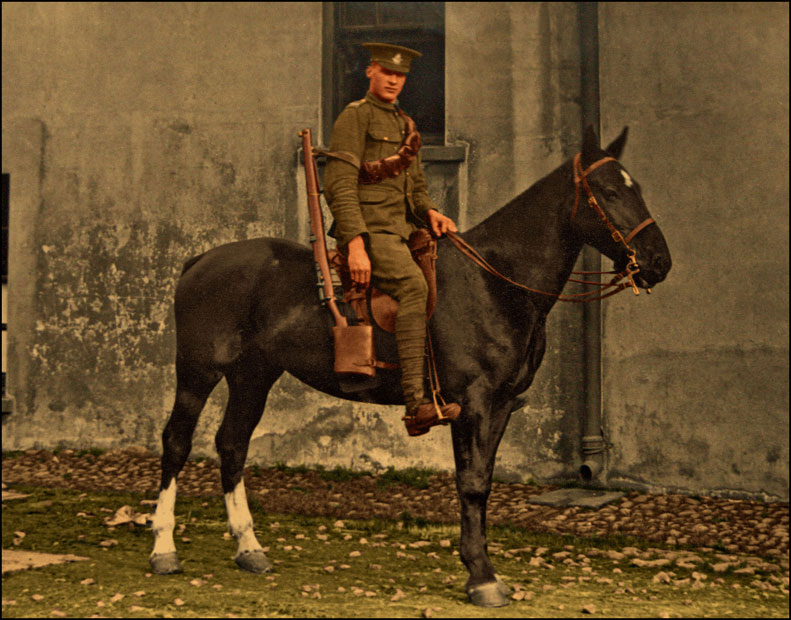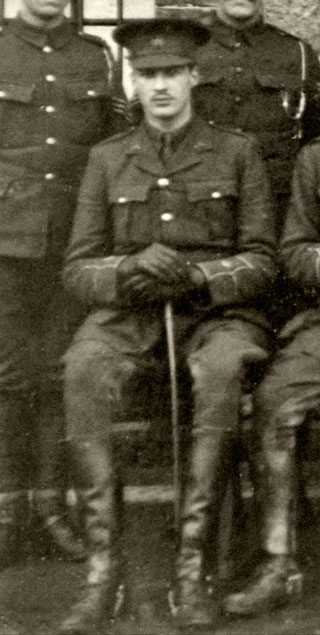Captain Ernest George Matthews

Ernest George Matthews was born on 8 February 1893 at Ava Terrace, Bangor, County Down, the last of four children of bank clerk William Matthews and his London-born wife Mary Ann Priscilla (Katie) (nee Hawkins). His father died just before Ernest's tenth birthday. From 1908 to 1913 Ernest served a five year apprenticeship as mill manager at William Ewart & Sons, Belfast.
Matthews enlisted in the North Irish Horse at Belfast on 20 August 1914 (No.1021). At the time he was living with his mother at 3 Cyrene Villas, Clifton Park Avenue, Belfast. He trained in the regiment's machine-gun detachment. On 24 November he applied for a commission and six days later was appointed 2nd lieutenant in the newly-formed 6th (Inniskilling) Dragoons Service Squadron.
On 6 October 1915 he embarked for France with his squadron, which was then serving as divisional cavalry to the 36th (Ulster) Division. The squadron's war diary mentions him twice over the following months:
[15 October 1915] Weather fine. 2/Lt Matthews left in charge of details at Bordon reported his arrival at Olincourt.
[26 January 1916] 2/Lieuts Matthews & McWilliam, Sergt Quinn & Lce Sergt Reid proceeded to the Div. School of Instruction at Le Meillard.
In June 1916 Matthews' squadron, together with F and C Squadrons of the North Irish Horse, were combined to form the 2nd North Irish Horse Regiment.
On the opening days of the Battle of the Somme Matthews was twice buried in a dugout by German shelling. On 5 July he was wounded in the knee during an artillery bombardment on Aveluy Wood. According to the regimental diary:
Orders were received from A.P.M. 36th Division at 9 am for the two troops dismounted to report to Capt O'Neill at Lancashire Dump for salvage duty. They carried out this duty bringing in equipment, rifles etc till 1 pm. The men had dinner and were just turning out again when Lieut Seymour received orders from 36th Division to return to Regtl Head Quarters. The men had just started to saddle up when a heavy bombardment of both high explosive, shrapnel & machine guns was concentrated on the Wood. The intensity of the fire necessitated Lt Seymour giving orders for the men to take shelter in some old dugouts & trenches close by. The bombardment lasted for 3/4 of an hour & then slackened but did not entirely stop. Up to now one horse was killed & four wounded. The men were then ordered to saddle up & lead their horses thro' Wood out on to the road and were waiting for the others to join up when the bombardment opened much heavier than previously especially on that part of the road where the men were waiting. Lt Seymour moved off up the road leaving 2/Lt Matthews & Sergt McIlvoy to round up the stragglers in the wood, as by this time horses were very restive and almost unmanagable. Lt Seymour with his party had reached about 1 mile along the road & turned down a lane leaving the horses in charge of Sergt Quinn. Almost immediately a heavy fire was brought to bear on the horses and Sergt Quinn was wounded. The horses stampeded in every direction, some back to Aveluy Wood. Eventually Lt Seymour was able to round up most of this party & got to Senlis. Lieut Matthews & Sergt McIlroy remained behind. Our losses numbered 16 horses killed or wounded and 2 missing. 2/Lt Matthews was wounded severely in the knee from high explosive and Pte Downes, Nicholl, Gourley wounded (hosp) and Ptes Buchanan, 195 Campbell, Totton, 105 Craig, Cpl Dickson, 209 Robinson slightly wounded (duty).
Matthews was evacuated to England for treatment. He was found unfit for duty and granted leave until 28 August, when a medical board reported:
... this officer was struck by a fragment of H.E. shell on the outer side of the rt knee. The actual wound was slight but the knee became extremely stiff & painful. He limps with a stick. His general condition is shakey. Previous to the injury he was twice buried in his dugout during the German bombardment. He sleeps badly & is in need of rest.
After further leave he was found fit for light duty and on 3 October 1916 reported for duty at the Inniskilling's reserve depot at Enniskillen. By 11 December he was once again fit for general service.
Matthews was appointed lieutenant on 30 October 1916.
It appears that he returned to France to rejoin his squadron in the 2nd North Irish Horse Regiment. The regiment's war diary reported:
[25 January 1917] Frosty. Routine work. Trench party under 2 Lt Matthews were shelled but had no casualties.
[8 February 1917] Frosty. Routine work. 2 Lt Matthews reports a quiet day with the working party.
However it appears that the impact of Matthews' earlier injuries were more long-lasting than first thought. On 23 April 1917 he was assessed at Rouen as unfit for frontline service due to DAH (disordered action of the heart). He was classed as PB (Permanent Base). On 2 July another assessment at Rouen classed him as PU (Permanently Unfit). On 20 August Matthews was transferred to the General List of Officers and put in command of No.104 Prisoner of War Company, Labour Corps, with the rank of acting captain. The promotion was confirmed on 20 April 1918.
He relinquished his commission on 1 September 1921.
After the war Matthews moved to England – his address given as The Cottage, Mill Road, Cleethorpes, Lincolnshire.
He applied for enrolment in the Army Officers' Emergency Reserve on 3 November 1939, but this was declined.
Captain Matthews' older brother, Sidney William Matthews, also served in the war, as a 2nd lieutenant in the Northumberland Fusiliers. According to a report in the Northern Whig of 23 August 1916, he suffered a severe face wound, "the bullet which injured him came out below the ear and severed two arteries."
The first image, part of a group photo of officers and NCOs of the Inniskillings squadron, appeared in the Belfast Evening Telegraph of 28 January 1915. The full image can be seen here. The second image shows Matthews as a private in the North Irish Horse in late 1914. Both images were kindly provided by Shaun Matthews, grandson of Captain Matthews, who also colourised the mounted photograph.

